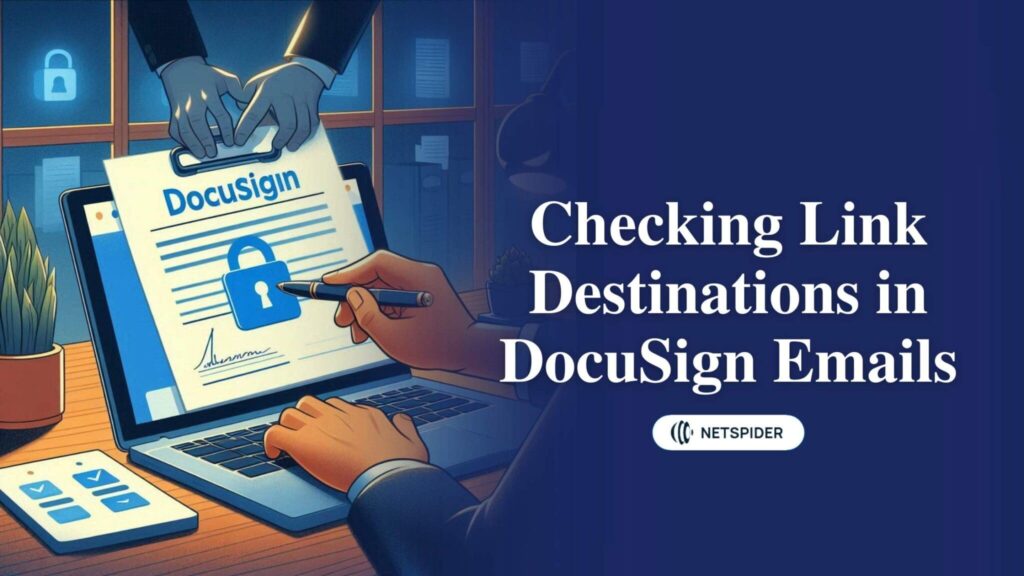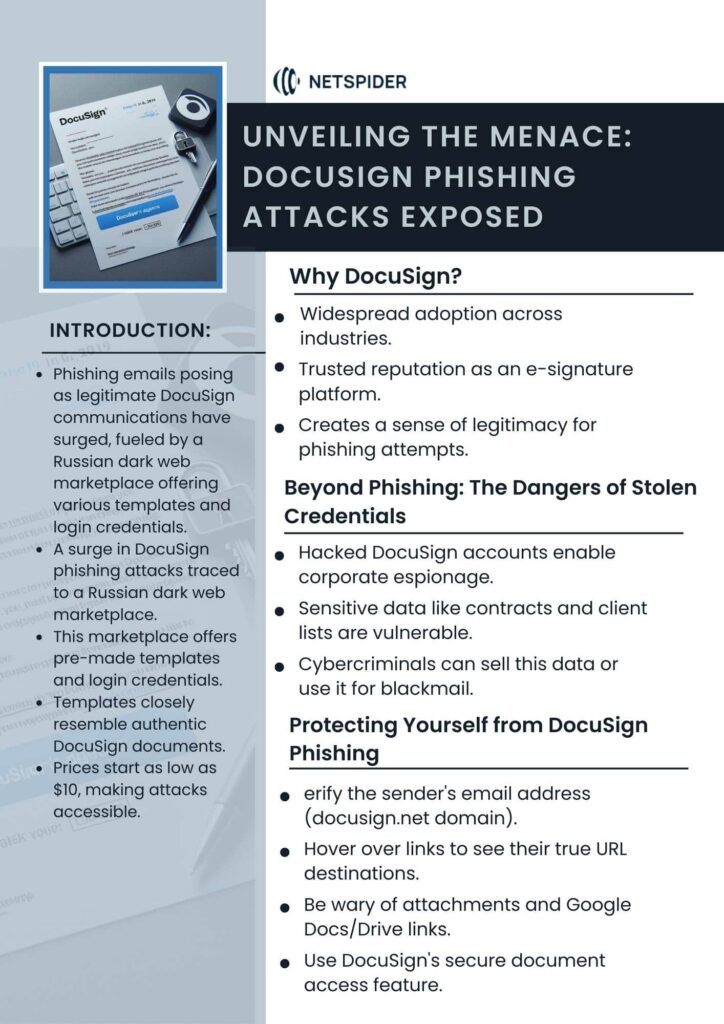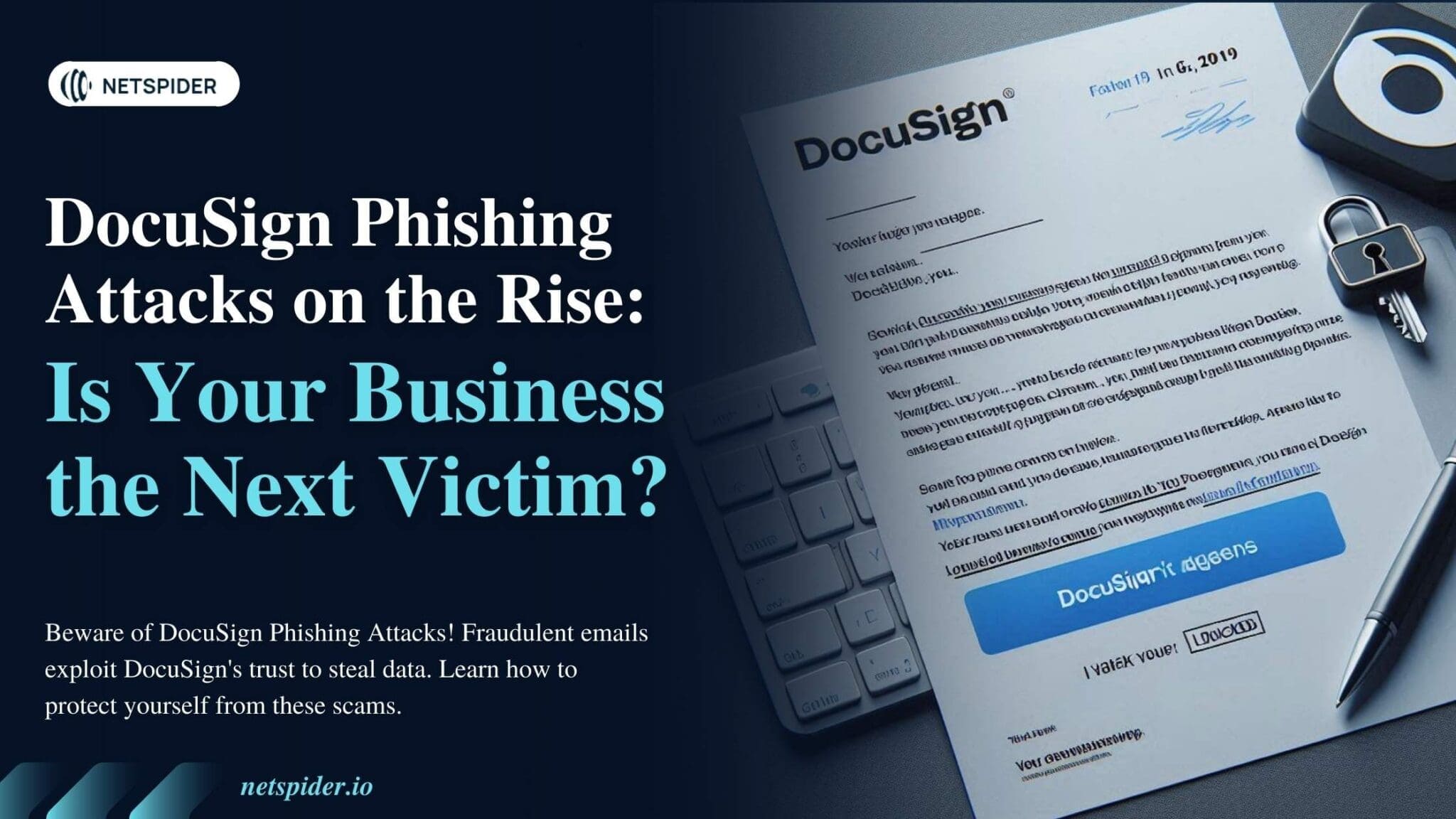A disturbing trend has emerged in recent months: DocuSign phishing attacks have increased, exploiting the service’s trusted reputation to deceiv unsuspecting users. These attacks, orchestrated through a Russian dark web marketplace that offers a variety of fake DocuSign templates and login credentials, pose a significant threat to individuals and organizations alike.
DocuSign Phishing Attacks: Unmasking the Dark Web Marketplace Fueling the Threat
Cybersecurity firms have reported a significant increase in DocuSign phishing attacks targeting their clients. Researchers traced the origins of these attacks to a dark web marketplace selling identical DocuSign templates used in phishing emails.
These fraudulent emails, meticulously crafted to mimic legitimate document signing requests, aim to trick unsuspecting recipients into clicking malicious links or divulging sensitive information. A threat researcher at a cybersecurity firm explained, “The DocuSign phishing attacks leverage the service’s trusted reputation. The surge in these attacks highlights the growing sophistication of cybercriminals and the need for heightened awareness.”
The widespread adoption of DocuSign across various industries makes it a prime target for these scams. Cybercriminals exploit this trust by creating convincing phishing emails that appear to originate from DocuSign.
The Deceptive Power of Authenticity in DocuSign Phishing Attacks
Phishing campaigns thrive on appearing legitimate. Cybercriminals meticulously craft emails to mimic trusted sources, maximizing their chances of deceiving targets. This tactic isn’t new, observed in scams impersonating postal services, and recent DocuSign phishing emails follow suit.
“Authenticity is paramount for cybercriminals launching phishing campaigns,” a threat researcher noted. They have two primary methods:
- Purchasing Templates: Reputable sellers on cybercrime forums offer pre-made templates, including those replicating DocuSign’s design.
- Direct Sign-Up: Cybercriminals may even subscribe to the targeted service (DocuSign in this case) to obtain genuine templates, further enhancing the deception.
- Both methods pose challenges. Purchasing templates carries exposure risks, while directly signing up requires advanced replication skills.

The Dark Web, A Breeding Ground for DocuSign Phishing Templates
Purchasing pre-made templates from underground marketplaces is the go-to method for cybercriminals. It’s fast, reduces exposure risks, and caters to their needs. Researchers have shed light on this concerning trend – sophisticated cybercriminals leveraging the dark web’s anonymity to trade DocuSign templates.
These templates are meticulously crafted to mimic genuine DocuSign documents, making them ideal tools for malicious activities. Phishing attacks, identity theft, and financial fraud become easier with such convincing templates.
The extent of the problem is alarming. Researchers discovered a discussion thread on a Russian dark web forum offering DocuSign templates and custom modifications to suit specific needs. This forum even boasted templates for services like delivery companies, with sellers promising exclusivity for a price. Further investigation revealed a vast marketplace teeming with similar templates for various companies, including tech giants and online payment services.
“Cybercriminals frequently launch multiple phishing campaigns simultaneously, targeting different vendors and services,” the report stated. These criminals streamline their operations and increase their profits by purchasing templates in bulk or outsourcing their creation.
The Malicious Mechanics of DocuSign Phishing Attacks
A mere $10 can equip cybercriminals with the tools to launch DocuSign phishing attacks. Phishing templates, readily available at this low cost, provide the foundation for these deceptive schemes.
Cybercriminals gain access to a goldmine of information once they acquire DocuSign login credentials through successful phishing campaigns. They can delve into a company’s files, searching for contracts, vendor agreements, or payment schedules. This stolen information becomes a weapon, allowing them to craft compelling phishing emails that appear legitimate.
Imagine receiving an email seemingly from DocuSign requesting a fund transfer to a partner and attaching a fabricated contract. To further heighten the illusion of legitimacy, these emails might be timed to coincide with real payment schedules, making them even more believable.
The threat doesn’t stop there. The report warns that compromised DocuSign accounts hold significant value for corporate espionage. Cybercriminals can exploit this access to steal sensitive information – details about upcoming mergers, financial records, and client lists. This stolen data can then be sold to other malicious actors or even used for blackmail, threatening to release the information publicly unless a ransom is paid.
Defending Against DocuSign Phishing Attacks
DocuSign’s popularity makes it a prime target for phishing scams. However, implementing key security measures can significantly reduce your risk of falling victim to these deceptive attacks.
Here’s what you can do to stay safe:
- Scrutinize the Sender’s Email Address: Legitimate DocuSign emails always originate from the “docusign.net” domain. Be wary of emails with sender addresses that differ from this format.
- Verify Recipient Personalization: Authentic DocuSign emails address recipients by name. Generic greetings like “Dear Customer” are a red flag.
- Inspect Link Destinations: Before clicking any links, hover over them with your mouse. This reveals the actual URL the link leads to. If the URL appears suspicious, do not click it.
- Beware of Suspicious Attachments and Links: Phishing emails often contain malicious attachments or links. Avoid opening attachments or clicking links from unsolicited emails, even those seemingly from DocuSign.

DocuSign’s Secure Document Access Feature: An Added Layer of Protection
DocuSign offers a secure document access feature to further safeguard users from phishing scams. Instead of clicking on links within suspicious emails, you can access documents directly through DocuSign’s official website. Navigate to docusign.net, click “Access Documents,” and enter the security code provided at the bottom of legitimate DocuSign emails.
By remaining vigilant and following these security practices, you can effectively shield yourself from DocuSign phishing attacks and protect sensitive information.
Source: securityboulevard.com
